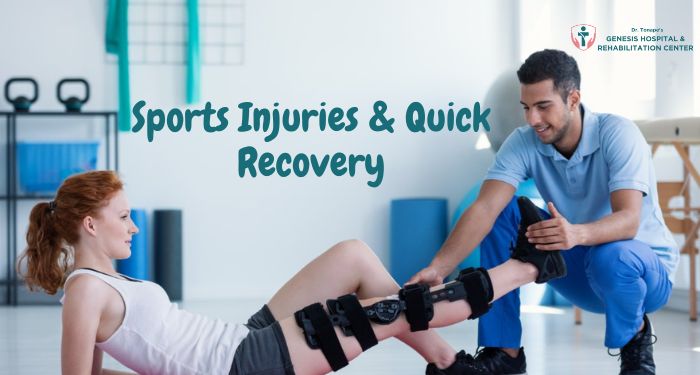Whether you’re a professional athlete, fitness enthusiast, or a weekend warrior, injuries are an unfortunate part of the game. From sprained ankles to ACL tears, sports injuries can severely affect performance, mobility, and long-term health. Fortunately, with the advancement in medical technology, sports injury treatment and recovery in 2025 is faster, smarter, and more effective than ever before.
Athletes today are not only looking to heal quickly but also to return to their sport stronger and safer. This is where an experienced orthopedic surgeon in PCMC and a multidisciplinary rehabilitation approach play a key role.
Understanding Common Sports Injuries
Let’s begin with the most common types of sports injuries seen among athletes across various disciplines:
1. Sprains and Strains
Sprains involve stretched or torn ligaments, while strains affect muscles or tendons. These usually occur due to overuse or sudden movement.
2. ACL Injuries
An ACL tear (Anterior Cruciate Ligament) is one of the most feared injuries in contact sports. It affects the knee’s stability and often requires surgical intervention followed by rehab.
3. Meniscus Tears
Caused by twisting the knee while bearing weight, a torn meniscus can result in pain, swelling, and restricted movement.
4. Shoulder Dislocations
Common in sports like swimming or cricket, shoulder injuries may involve rotator cuff tears or complete dislocation.
5. Tennis Elbow and Golfer’s Elbow
These overuse injuries involve inflammation in the tendons and are common in racquet or repetitive-motion sports.
6. Stress Fractures
Caused by repeated impact on bones, stress fractures are common in runners and jumpers and often need rest and medical evaluation.
Why Consult an Orthopedic Surgeon?
A qualified orthopedic surgeon in PCMC can accurately diagnose the type and severity of your injury using physical exams, X-rays, and MRI scans. More importantly, they guide you through a comprehensive recovery plan, whether it involves surgery, physiotherapy, or regenerative treatment.
Latest Advances in Sports Injury Treatment (2025)
1. Arthroscopic Surgery
Minimally invasive, this technique uses small incisions and cameras to repair ligaments and tissues with faster healing times and less scarring.
2. PRP Therapy (Platelet-Rich Plasma)
This regenerative technique uses your blood’s healing factors to promote faster recovery in soft tissue injuries, reducing the need for invasive procedures.
3. Stem Cell Therapy
Stem cells are now used to regenerate cartilage and tendon tissues, especially in chronic or degenerative injuries.
4. 3D Motion Analysis
Used to evaluate gait and joint mechanics post-injury, this helps in planning accurate physiotherapy and preventing future injuries.
5. Wearable Tech in Rehab
Smart braces, motion sensors, and AI-powered devices monitor joint movements, track recovery, and improve rehab compliance.
Sports Rehabilitation: The Key to Faster, Safer Recovery
Proper rehab is as important as the treatment itself. Rushing back to activity without healing fully can cause re-injury or long-term damage.
Key components of effective sports rehab:
-
Physiotherapy for athletes to restore strength and flexibility
-
Range-of-motion exercises to prevent stiffness
-
Progressive loading techniques to build endurance
-
Balance and coordination drills
-
Nutritional support for tissue repair
-
Mental health counseling, especially after major injuries
A tailored rehab program led by a team of professionals ensures full recovery and return to peak performance.
Preventing Future Injuries
Injury prevention is better than cure—especially for athletes. Here are some tips to avoid common pitfalls:
-
Warm up thoroughly before training or competition
-
Use proper technique and equipment
-
Don’t ignore pain—early treatment avoids complications
-
Cross-train to avoid overuse of the same muscle groups
-
Stay hydrated and maintain proper nutrition
-
Schedule routine evaluations with an orthopedic doctor to assess your risk factors
Choosing the Right Orthopedic Specialist in PCMC
When dealing with sports injuries, experience and specialization matter. A trained orthopedic surgeon in PCMC who deals with athletic injuries will offer:
-
Accurate and early diagnosis
-
Advanced surgical and non-surgical treatment
-
Customized rehab plans
-
Advice on safe return-to-play timelines
-
Long-term care for chronic or recurrent issues
Their guidance can be the difference between a prolonged career and recurring injury struggles.
Athletes Who Made a Comeback
To inspire you, here are some world-class athletes who came back stronger after injury—thanks to the right medical team:
-
Virat Kohli – dealt with back issues but returned with better conditioning
-
Roger Federer – had multiple knee surgeries yet kept performing at the top
-
Mary Kom – overcame shoulder injuries and returned to boxing
With personalized care and discipline, recovery is possible—even at elite levels.
Sports Injury Treatment Across Age Groups
Whether it’s a 15-year-old footballer or a 45-year-old weekend marathoner, sports medicine is no longer age-specific. The key is timely intervention and age-appropriate rehab strategies.
For younger athletes, growth plate protection and injury awareness are crucial. For adults, focus shifts to joint preservation, mobility, and strength-building.
Conclusion
In 2025, sports injuries no longer mean months of helplessness. With cutting-edge treatment, scientific rehab, and experienced professionals, you can bounce back stronger than ever. Whether it’s a mild strain or a full ligament tear, the journey to recovery begins with the right orthopedic guidance.
If you or someone you know is dealing with a sports injury, don’t delay. A consultation with a skilled orthopedic surgeon in PCMC can help diagnose the issue early and create a roadmap to a safe and complete recovery.
Remember, the goal isn’t just to heal—but to come back stronger, safer, and smarter

